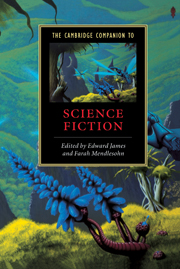Book contents
- Frontmatter
- Introduction
- Part 1 The history
- Part 2 Critical approaches
- Part 3 Sub-genres and themes
- 11 The icons of science fiction
- 12 Science fiction and the life sciences
- 13 Hard science fiction
- 14 Space opera
- 15 Alternate history
- 16 Utopias and anti-utopias
- 17 Politics and science fiction
- 18 Gender in science fiction
- 19 Race and ethnicity in science fiction
- 20 Religion and science fiction
- Further Reading
- Index
- Series List
20 - Religion and science fiction
from Part 3 - Sub-genres and themes
Published online by Cambridge University Press: 28 May 2006
- Frontmatter
- Introduction
- Part 1 The history
- Part 2 Critical approaches
- Part 3 Sub-genres and themes
- 11 The icons of science fiction
- 12 Science fiction and the life sciences
- 13 Hard science fiction
- 14 Space opera
- 15 Alternate history
- 16 Utopias and anti-utopias
- 17 Politics and science fiction
- 18 Gender in science fiction
- 19 Race and ethnicity in science fiction
- 20 Religion and science fiction
- Further Reading
- Index
- Series List
Summary
The fascination of sf with faith and with ritual can be located in the geography of two strands of genre development. The first, scientific romance, bestowed upon sf a sense of grandeur and wonder at the cosmos and its works. From the scientific romance were drawn the great space operas of E. E. 'Doc' Smith, the spiritual journeys of David Lindsay (A Voyage to Arcturus, 1920) and the eschatological futurism of Olaf Stapledon. While the scientific romance did not support a religious interpretation of the world, it revelled in the immaterial and imparted to genre sf a desire for the transcendent; this vision of the future represented an attempt to peer into the heavens. The second, sf as it developed in the pulp magazines, leaned towards a much more material and ritualistic understanding of religion and, on the surface at least, this became the dominant mode of the sf encounter with religion.
Genre publishing began in the USA in the 1920s and much of what I describe in this chapter is consequent upon this specific cultural milieu. Most superficial accounts of the USA in this period adopt a particularist, northeastern approach in which America emerges into scientific and political rationalism at the beginning of the twentieth century. Yet most Americans remained deeply religious. From 1926 onwards, while court cases appeared to be ruling for ever greater secularization, legislation restricting the teaching of scientific knowledge and method quietly sneaked on to local statute books (this did not come to light until the curriculum reforms of the late 1950s, prompted by the Russian launch of Sputnik). By 1960, secularism, or at least a liberal interpretation of most faiths, provided an apparently hegemonic intellectual tradition in the USA.
- Type
- Chapter
- Information
- The Cambridge Companion to Science Fiction , pp. 264 - 275Publisher: Cambridge University PressPrint publication year: 2003
- 10
- Cited by



